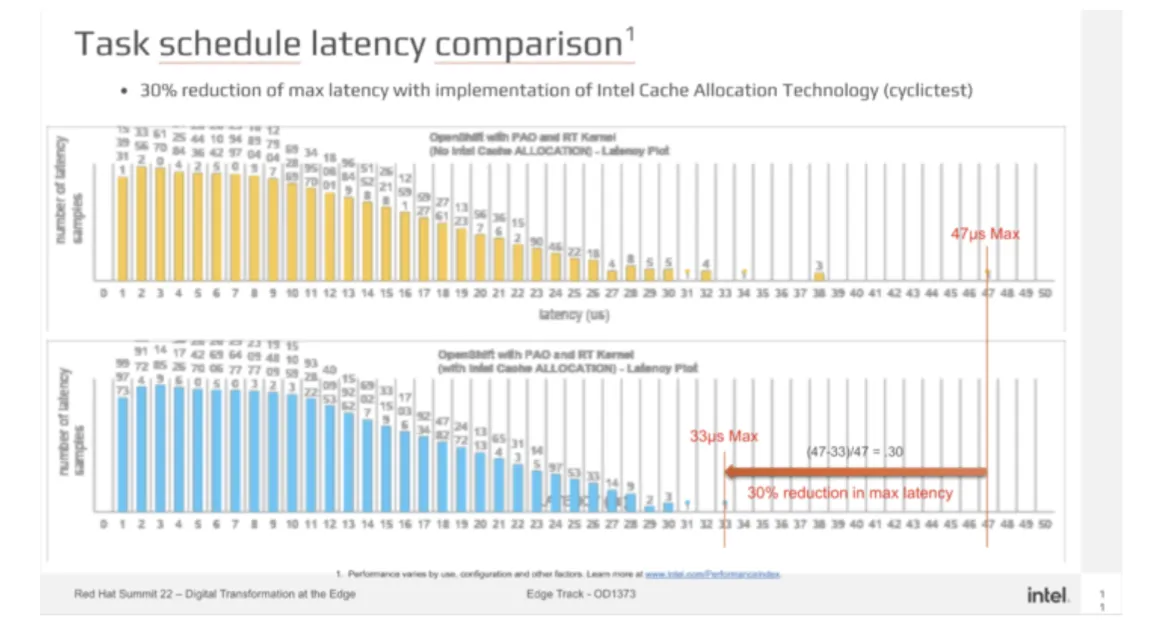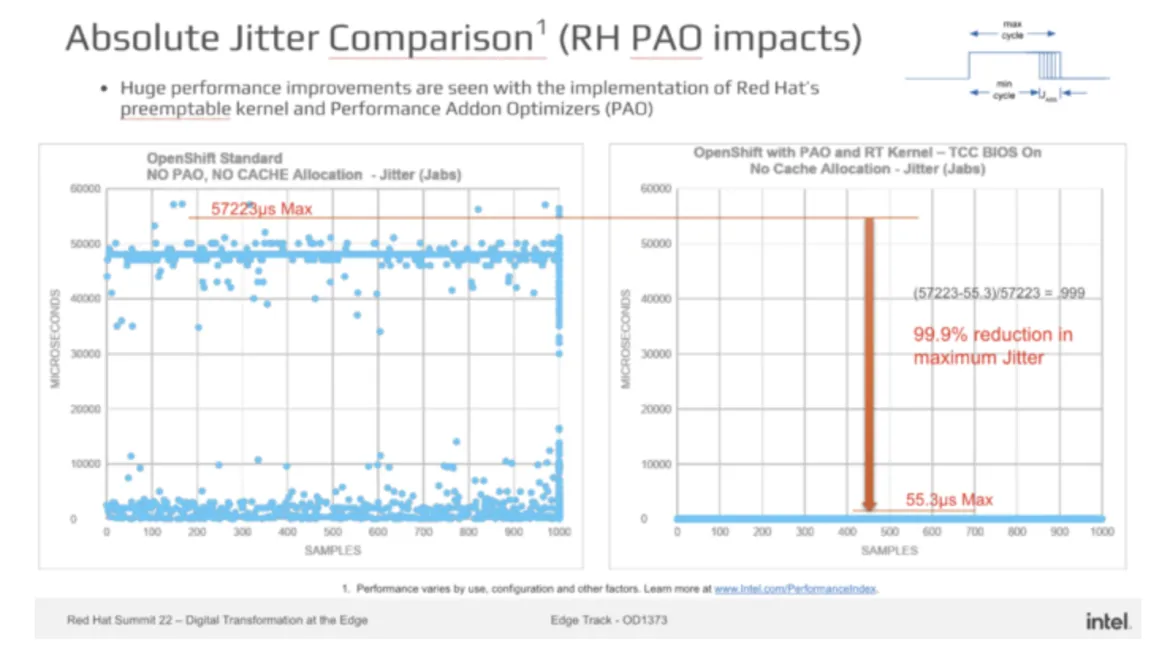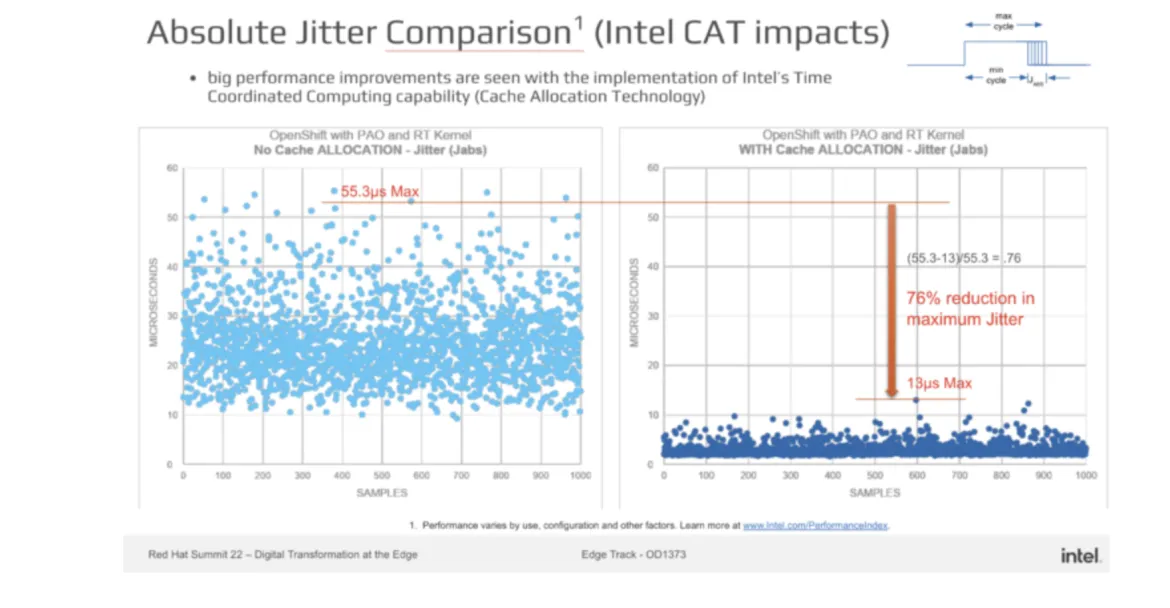The software-defined industrial control system is a huge opportunity for open source technologies. Moving away from bespoke specialized hardware (like PLC devices) to standard hardware with software only is a trend that crosses industries, extending now into the industrial and manufacturing world. This type of shift for industrial organizations is similar to telcos moving to network function virtualisation (NFV) and open radio access networks (ORAN).
Successfully implementing this trend, however, requires low latency capabilities. The controller has to respond quickly to an external event, such as a robot hitting a wall and stopping it before it actually makes contact. Please note that I avoid the term "real time", which requires specialized Real Time Operating Systems (RTOS). Instead, the best term to use is "predictable latency."
One of Red Hat’s answers to this burgeoning industrial trend is Red Hat Enterprise Linux (RHEL) for Real Time, which serves as the base for the Red Hat OpenShift Performance Addon Operator (PAO). While this was developed for the telco space, it’s very suitable for reuse for operational technologies and industrial control systems.
Together with Intel, we presented Digital Transformation at the Edge with Red Hat and Intel Edge Controls for Industrial, the result of a combined testing and evaluation effort between our two companies.
Let's take a look at the data:
 This test is done using Red Hat OpenShift on bare metal with the Performance Add-On Operator and the RHEL Real-Time kernel (RT-Kernel). Max latency (the time from event to response) is around 47 µsec to 33 µsec. This is more or less out of the box on standard hardware, with next to no special tuning besides activating Intel Cache Allocation Technology. This is already good enough for many industrial control system applications with PLC cycle times in the ~10 msec range, leaving enough headroom for the actual program execution.
This test is done using Red Hat OpenShift on bare metal with the Performance Add-On Operator and the RHEL Real-Time kernel (RT-Kernel). Max latency (the time from event to response) is around 47 µsec to 33 µsec. This is more or less out of the box on standard hardware, with next to no special tuning besides activating Intel Cache Allocation Technology. This is already good enough for many industrial control system applications with PLC cycle times in the ~10 msec range, leaving enough headroom for the actual program execution.
But it gets even better:
 This chart shows the value of the OpenShift Performance Add-On Operator and the RHEL RT-Kernel it deploys. Note that we switched from latency (how quickly does the system respond) to jitter (how consistently does the system respond, which is actually more important). You can see on a default system (standard kernel), it is around 57 msec — not acceptable for most control applications.
This chart shows the value of the OpenShift Performance Add-On Operator and the RHEL RT-Kernel it deploys. Note that we switched from latency (how quickly does the system respond) to jitter (how consistently does the system respond, which is actually more important). You can see on a default system (standard kernel), it is around 57 msec — not acceptable for most control applications.
But just by turning on the OpenShift Performance Add On Operator, with no additional tuning, this drops down to 55 µsec. That's an improvement of three orders of magnitude.
Let's take a look at what's possible when we add Intel capabilities to the equation:
 The reason for the left hand side wide deviations is CPU cache misses. If the code/data is not in the cache, it takes quite some time to fetch it from memory. First and second level caches can be disturbed by other workloads or processes running on the same core. Intel Cache Allocation Technology avoids this by dedicating parts of the CPU cache to a process.
The reason for the left hand side wide deviations is CPU cache misses. If the code/data is not in the cache, it takes quite some time to fetch it from memory. First and second level caches can be disturbed by other workloads or processes running on the same core. Intel Cache Allocation Technology avoids this by dedicating parts of the CPU cache to a process.
Looking at the new numbers, the old minimum turns into the new maximum, with a 76% reduction in max jitter.
Conclusion
The numbers show that low latency workload like industrial control systems can run on modern standard hardware in containerized environments. No need for special purpose devices, no need for long lasting heavy fine tuning. The out of the box performance characteristics are good enough for most use cases.
Sull'autore
Daniel works as a Principal Product Manager at Red Hat. He is responsible for defining and managing the Red Hat OpenShift edge related projects including: MicroShift, Red Hat Device Edge and Single Node OpenShift products. Daniel is a catalyst that brings together the necessary resources (people, technology, methods) to make projects and products a success. Daniel has more than 25 years of experience in IT. In the past years, Daniel has focused on hybrid cloud and container technologies in the Industrial space.
Altri risultati simili a questo
Ricerca per canale
Automazione
Novità sull'automazione IT di tecnologie, team e ambienti
Intelligenza artificiale
Aggiornamenti sulle piattaforme che consentono alle aziende di eseguire carichi di lavoro IA ovunque
Hybrid cloud open source
Scopri come affrontare il futuro in modo più agile grazie al cloud ibrido
Sicurezza
Le ultime novità sulle nostre soluzioni per ridurre i rischi nelle tecnologie e negli ambienti
Edge computing
Aggiornamenti sulle piattaforme che semplificano l'operatività edge
Infrastruttura
Le ultime novità sulla piattaforma Linux aziendale leader a livello mondiale
Applicazioni
Approfondimenti sulle nostre soluzioni alle sfide applicative più difficili
Serie originali
Raccontiamo le interessanti storie di leader e creatori di tecnologie pensate per le aziende
Prodotti
- Red Hat Enterprise Linux
- Red Hat OpenShift
- Red Hat Ansible Automation Platform
- Servizi cloud
- Scopri tutti i prodotti
Strumenti
- Formazione e certificazioni
- Il mio account
- Supporto clienti
- Risorse per sviluppatori
- Trova un partner
- Red Hat Ecosystem Catalog
- Calcola il valore delle soluzioni Red Hat
- Documentazione
Prova, acquista, vendi
Comunica
- Contatta l'ufficio vendite
- Contatta l'assistenza clienti
- Contatta un esperto della formazione
- Social media
Informazioni su Red Hat
Red Hat è leader mondiale nella fornitura di soluzioni open source per le aziende, tra cui Linux, Kubernetes, container e soluzioni cloud. Le nostre soluzioni open source, rese sicure per un uso aziendale, consentono di operare su più piattaforme e ambienti, dal datacenter centrale all'edge della rete.
Seleziona la tua lingua
Red Hat legal and privacy links
- Informazioni su Red Hat
- Opportunità di lavoro
- Eventi
- Sedi
- Contattaci
- Blog di Red Hat
- Diversità, equità e inclusione
- Cool Stuff Store
- Red Hat Summit

